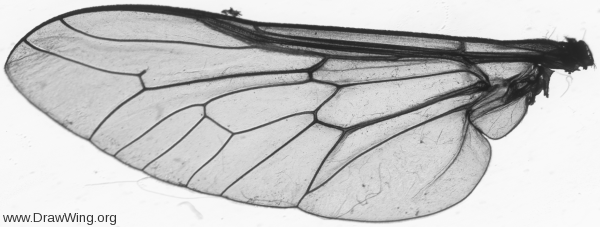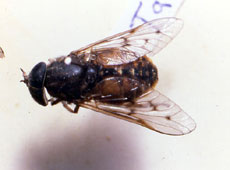
Adaptation
Species belonging to the genus
Tabanus have developed
into the one of the largest genus of the “True flies.”
They are very strong fliers, which allows the females to fly
just out of reach of their vertebrate prey and the males to rapidly
fly from flower to flower feeding on nectar (Arnett
1985). One
species that is closely related to
Tabanus longiglossus (in
the same genus) can reach flight speeds of 150 km/hour (Resh
and Carde
2003)! Some
adaptations that characterize the genus Tabanus may have arose
allowing for their rapid flight.
One of these adaptations is a body that lacks bristles.
Another adaptation is their distinctively large calypteres
(lobes located at the posterior side of the wing) (Arnett
1985). We
believe that there should be some additional study done to see if
there is any correlation between their unusually large calypteres
and body that largely lacks bristles (these are unique to this
genus) that result in their increased flight speed.
Tabanus longiglossus
wings are similar to the rest of the flying insects given that
they are thin and membranous.
Just like the rest of the species falling under the order
Diptera, they have only one pair of primary flight wings called
patent flight wings and a reduced set of halteres, which are used
for balance in flight (Wilegmann,
2007). Their
wings are almost transparent and either colorless or smoky (Resh
and Carde
2003). This
species also has an annulated, as opposed to a segmented, antennae (Borror
and White
1970).
Another adaptation Tabanus
longiglossus has developed is their large compound eyes.
They are very large and compose almost all of their head.
They are generally green or purple earning them the name
“green heads.” To learn other
nicknames for horseflies you can go to the
interesting facts page of this website. The eyes
are separated in the females, but are united dorsally in the males (Arnett
1985). These
eyes give them an acute sense of sight allowing the females to use
visual cues to locate host that they can feed upon.
They are also, amazingly, able to sense plumes of carbon
dioxide produced during respiration of the vertebrates they seek to
feed upon (Resh
and Carde
2003).
Tabanus may have arose
allowing for their rapid flight.
One of these adaptations is a body that lacks bristles.
Another adaptation is their distinctively large calypteres
(lobes located at the posterior side of the wing) (Arnett
1985). We
believe that there should be some additional study done to see if
there is any correlation between their unusually large calypteres
and body that largely lacks bristles (these are unique to this
genus) that result in their increased flight speed.
Tabanus longiglossus
wings are similar to the rest of the flying insects given that
they are thin and membranous.
Just like the rest of the species falling under the order
Diptera, they have only one pair of primary flight wings called
patent flight wings and a reduced set of halteres, which are used
for balance in flight (Wilegmann,
2007). Their
wings are almost transparent and either colorless or smoky (Resh
and Carde
2003). This
species also has an annulated, as opposed to a segmented, antennae (Borror
and White
1970).
Another adaptation Tabanus
longiglossus has developed is their large compound eyes.
They are very large and compose almost all of their head.
They are generally green or purple earning them the name
“green heads.” To learn other
nicknames for horseflies you can go to the
interesting facts page of this website. The eyes
are separated in the females, but are united dorsally in the males (Arnett
1985). These
eyes give them an acute sense of sight allowing the females to use
visual cues to locate host that they can feed upon.
They are also, amazingly, able to sense plumes of carbon
dioxide produced during respiration of the vertebrates they seek to
feed upon (Resh
and Carde
2003).
